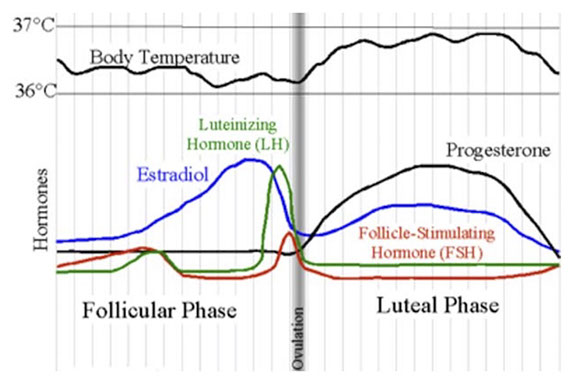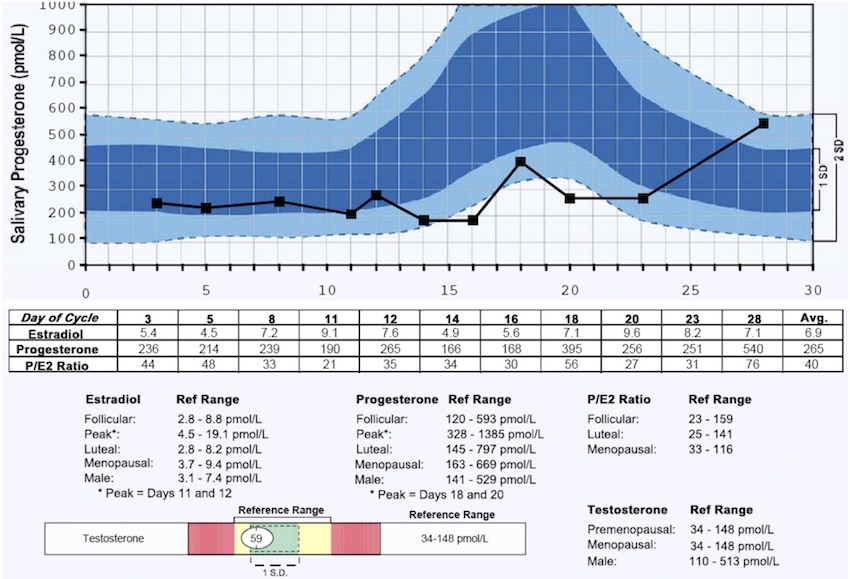Basic Overview of the Female Cycle
Optimal health in women depends on healthy menstrual function.
Abnormal function of the monthly menstrual pattern plays a critical role in infertility, PMS and dysmenorrhea.
In addition the following symptoms may be due to a dysfunctional menstrual pattern: emotional fragility, mood swings, anxiety, panic attacks, hot flashes, night sweats, bloating, excessive weight gain or loss, excessively high or low energy, chronic digestive upset, migraine headaches, repeated miscarriage.
In addition the following symptoms may be due to a dysfunctional menstrual pattern:
- Emotional fragility
- Mood swings
- Anxiety
- Panic attacks
- Hot flashes
- Night sweats
- Bloating, excessive weight gain or loss, excessively
- High or low energy
- Chronic digestive upset
- Migraine headaches
- Repeated miscarriage

Assessing the Female Hormonal System
Signs and Symptoms of Female Endocrine Dysfunction:
Many of the signs and symptoms associated with the female endocrine system involve issues of PMS, menopause, menstrual irregularity, and problems with fertility.
All of these conditions have a variety of causes. You will find that in many cases simply addressing general health issues will make a huge difference for these dysfunctions.
You can resolve a large number of the problems in the female endocrine system by resolving the following foundational issues:
- Digestive dysfunction
- Mucosal barrier function
- Blood sugar dysregulation
- Thyroid hormone imbalance
- Nutritional deficiencies
- Toxicity issues
Female Hormonal Dysfunctions and Foundational Issues:
Consider the relationship between the following female hormone dysfunctions and other systems we have already covered in this section:
- Mood swings during the menstrual cycle can be the result of poor thyroid function.
- Poor liver function or dysbiosis can cause imbalance between progesterone and estrogen.
- Menopausal hot flashes can be the result of poor adrenal function or EFA deficiency.
Signs and symptoms associated with female endocrine problems:
- Depression during periods
- Mood swings associated with periods (PMS)
- Crave chocolate around periods
- Breast tenderness associated with cycle
- Excessive menstrual flow
- Scanty blood flow during periods
- Occasional skipped periods
- Variations in menstrual cycles
- Endometriosis
- Uterine fibroids
- Breast fibroids, benign masses
- Painful intercourse (dysparenia)
- Vaginal discharge
- Vaginal dryness
- Vaginal itchiness
- Gain weight around hips, thighs and buttocks
- Excess facial or body hair
- Hot flashes
- Night sweats (in menopausal females)
- Thinning skin
When progesterone levels drop to near zero, estrogen dominance occurs with side effects including:
- Water retention
- Swelling (edema)
3. Fatigue, lack of energy
4. Breast swelling
5. Premenstrual mood swings
6. Loss of sex drive
7. Uterine fibroids
8. Cravings for sweets
9. Weight gain, fatty deposits in thighs and hips
10. Cold hands, cold feet (low thyroid)

Treatment of Abnormal Female Hormone Cycle
Low Estradiol:
- Multi vitamin/mineral formula
- Boron
- Panax ginseng
- Black cohosh
- Sage
- Red Clover Tops
- Fenugreek
- Glandulars
- Ovarian tissue
- Pituitary tissue
- Adrenal tissue
- Bio-Identical Hormone Replacement
- Estradiol (E2) – (Prescription only)
- Estriol (E3) – (Prescription only)
- DHEA (as a precursor) 2-25mg/day
High Estradiol:
- DIM
- Indole-3-carbinol
- Calcium D-Glucarate
- Saw palmetto
- Chaste Tree
- Detox
Low Progesterone:
- Multi vitamin/mineral formula
- Chaste Tree
- Glandulars
- Ovarian tissue
- Pituitary tissue
- Adrenal tissue
- Bio-Identical Hormone Replacement
- Progesterone
- Continuous therapy 100-200mg/day
- Cycling therapy 200-400mg for 10-14 day cycle
- Pregnenolone (as a precursor) 5-10mg/day
- Progesterone
High Progesterone
- DIM
- Indole-3-carbinol
- Calcium D-Glucarate
- Detox
Low Testosterone
- Stinging nettle
- Glandulars
- Ovarian tissue
- Pituitary tissue
- Adrenal tissue
- Bio-Identical Hormonal Replacement
- Testosterone (Prescription Only)
- DHEA (as a precursor) 2-25mg/day
High Testosterone
- DIM
- Indole-3-carbinol
- Calcium D-Glucarate
- Saw Palmetto
- Chaste Tree
- Detox
